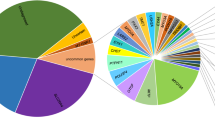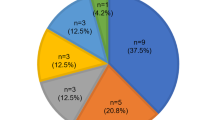Abstract
Hearing loss (HL) is a heterogenous trait with pathogenic variants in more than 200 genes that have been discovered in studies involving small and large HL families. Over one-third of families with hereditary HL remain etiologically undiagnosed after screening for mutations in the recognized genes. Genetic heterogeneity complicates the analysis in multiplex families where variants in more than one gene can be causal in different individuals even in the same sibship. We employed exome or genome sequencing in at least two affected individuals with congenital or prelingual-onset, severe to profound, non-syndromic, bilateral sensorineural HL from four multiplex families. Bioinformatic analysis was performed to identify variants in known and candidate deafness genes. Our results show that in these four families, variants in a single HL gene do not explain HL in all affected family members, and variants in another known or candidate HL gene were detected to clarify HL in the entire family. We also present a variant in TOGARAM2 as a potential cause underlying autosomal recessive non-syndromic HL by showing its presence in a family with HL, its expression in the cochlea and the localization of the protein to cochlear hair cells. Conclusively, analyzing all affected family members separately can serve as a good source for the identification of variants in known and novel candidate genes for HL.
This is a preview of subscription content, access via your institution
Access options
Subscribe to this journal
Receive 12 print issues and online access
$259.00 per year
only $21.58 per issue
Buy this article
- Purchase on Springer Link
- Instant access to full article PDF
Prices may be subject to local taxes which are calculated during checkout



Similar content being viewed by others
Data availability
All data generated or analyzed during this study are included in this article and its supplementary information files. The genetic variants are submitted to ClinVar database; accession IDs SCV004022367 and SCV004022368.
References
McGinniss MJ, Kaback MM. Heterozygote testing and carrier screening. Emery and Rimoin’s principles and practice of medical genetics: Elsevier; 2013. p. 1–10.
Pandya A, O’Brien A, Kovasala M, Bademci G, Tekin M, Arnos KS. Analyses of del (GJB6‐D13S1830) and del (GJB6‐D13S1834) deletions in a large cohort with hearing loss: Caveats to interpretation of molecular test results in multiplex families. Mol Genet Genom Med. 2020;8:e1171.
Mazzoli M, Van Camp G, Newton V, Giarbini N, Declau F, Parving A. Recommendations for the description of genetic and audiological data for families with nonsyndromic hereditary hearing impairment. Audiol Med. 2003;1:148–50.
Krumm N, Sudmant PH, Ko A, O’Roak BJ, Malig M, Coe BP, et al. Copy number variation detection and genotyping from exome sequence data. Genome Res. 2012;22:1525–32.
Chen X, Schulz-Trieglaff O, Shaw R, Barnes B, Schlesinger F, Källberg M, et al. Manta: rapid detection of structural variants and indels for germline and cancer sequencing applications. Bioinformatics. 2016;32:1220–2.
Rausch T, Zichner T, Schlattl A, Stütz AM, Benes V, Korbel JO. DELLY: structural variant discovery by integrated paired-end and split-read analysis. Bioinformatics. 2012;28:i333–i9.
Abyzov A, Urban AE, Snyder M, Gerstein M. CNVnator: an approach to discover, genotype, and characterize typical and atypical CNVs from family and population genome sequencing. Genome Res. 2011;21:974–84.
Richards S, Aziz N, Bale S, Bick D, Das S, Gastier-Foster J, et al. Standards and guidelines for the interpretation of sequence variants: a joint consensus recommendation of the American College of Medical Genetics and Genomics and the Association for Molecular Pathology. Genet Med. 2015;17:405–23.
Oza AM, DiStefano MT, Hemphill SE, Cushman BJ, Grant AR, Siegert RK, et al. Expert specification of the ACMG/AMP variant interpretation guidelines for genetic hearing loss. Hum Mutat. 2018;39:1593–613.
Tavtigian SV, Harrison SM, Boucher KM, Biesecker LG. Fitting a naturally scaled point system to the ACMG/AMP variant classification guidelines. Hum Mutat.2020;41:1734–7.
Sobreira N, Schiettecatte F, Valle D, Hamosh A. GeneMatcher: a matching tool for connecting investigators with an interest in the same gene. Hum Mutat. 2015;36:928–30.
Tollefson MR, Gogal RA, Weaver AM, Schaefer AM, Marini RJ, Azaiez H, et al. Assessing variants of uncertain significance implicated in hearing loss using a comprehensive deafness proteome. Hum Genet. 2023;142:819–34.
Conant D, Hsiau T, Rossi N, Oki J, Maures T, Waite K, et al. Inference of CRISPR edits from Sanger trace data. CRISPR J. 2022;5:123–30.
Ikenouchi J, Furuse M, Furuse K, Sasaki H, Tsukita S, Tsukita S. Tricellulin constitutes a novel barrier at tricellular contacts of epithelial cells. J Cell Biol. 2005;171:939–45.
Cheng J, Novati G, Pan J, Bycroft C, Žemgulytė A, Applebaum T, et al. Accurate proteome-wide missense variant effect prediction with AlphaMissense. Science. 2023;381:eadg7492.
Danzi MC, Dohrn MF, Fazal S, Beijer D, Rebelo AP, Cintra V, et al. Deep structured learning for variant prioritization in Mendelian diseases. Nat Commun. 2023;14:4167.
Bonthron DT, Brady N, Donaldson LA, Steinmann B. Molecular basis of essential fructosuria: molecular cloning and mutational analysis of human ketohexokinase (fructokinase). Hum Mol Genet. 1994;3:1627–31.
Petit C. From deafness genes to hearing mechanisms: harmony and counterpoint. Trends Mol Med. 2006;12:57–64.
Sirmaci A, Edwards YJ, Akay H, Tekin M. Challenges in whole exome sequencing: an example from hereditary deafness. PLoS One. 2012;7:e32000.
Chong JX, Buckingham KJ, Jhangiani SN, Boehm C, Sobreira N, Smith JD, et al. The genetic basis of Mendelian phenotypes: discoveries, challenges, and opportunities. Am J Hum Genet. 2015;97:199–215.
Ramzan M, Duman D, Hendricks LCP, Guo S, Mutlu A, Kalcioglu MT, et al. Genome sequencing identifies coding and non-coding variants for non-syndromic hearing loss. J. Hum. Genet. 2023;68:1–13.
Rehman AU, Santos-Cortez RLP, Drummond MC, Shahzad M, Lee K, Morell RJ, et al. Challenges and solutions for gene identification in the presence of familial locus heterogeneity. Eur J Hum Genet 2015;23:1207–15.
Naz S, Imtiaz A, Mujtaba G, Maqsood A, Bashir R, Bukhari I, et al. Genetic causes of moderate to severe hearing loss point to modifiers. Clin Genet 2017;91:589–98.
Richard EM, Santos‐Cortez RLP, Faridi R, Rehman AU, Lee K, Shahzad M, et al. Global genetic insight contributed by consanguineous Pakistani families segregating hearing loss. Hum Mutat 2019;40:53–72.
Lu Y, Zhou X, Jin Z, Cheng J, Shen W, Ji F, et al. Resolving the genetic heterogeneity of prelingual hearing loss within one family: Performance comparison and application of two targeted next-generation sequencing approaches. J Hum Genet. 2014;59:599–607.
Das A, Dickinson DJ, Wood CC, Goldstein B, Slep KC. Crescerin uses a TOG domain array to regulate microtubules in the primary cilium. Mol Biol Cell 2015;26:4248–64.
Perlaza K, Mirvis M, Ishikawa H, Marshall W. The short flagella 1 (SHF1) gene in Chlamydomonas encodes a Crescerin TOG-domain protein required for late stages of flagellar growth. Mol Bio Cell 2022;33:ar12.
Belyantseva IA, Labay V, Boger ET, Griffith AJ, Friedman TB. Stereocilia: the long and the short of it. Trends Mol Med 2003;9:458–61.
Miyoshi T, Belyantseva IA, Kitajiri S-I, Miyajima H, Nishio S-Y, Usami S-I, et al. Human deafness-associated variants alter the dynamics of key molecules in hair cell stereocilia F-actin cores. Hum. Genet. 2021;141:1-20.
Riazuddin S, Ahmed ZM, Fanning AS, Lagziel A, Kitajiri S, Ramzan K, et al. Tricellulin is a tight-junction protein necessary for hearing. Am. J. Hum. Genet. 2006;79:1040–51.
Van Hauwe P, Everett LA, Coucke P, Scott DA, Kraft ML, Ris-Stalpers C, et al. Two frequent missense mutations in Pendred syndrome. Hum. Mol. Genet. 1998;7:1099–104.
Cassatella D, Howard SR, Acierno JS, Xu C, Papadakis GE, Santoni FA, et al. Congenital hypogonadotropic hypogonadism and constitutional delay of growth and puberty have distinct genetic architectures. Eur. J. Endocrinol. 2018;178:377–88.
Vona B, Maroofian R, Mendiratta G, Croken M, Peng S, Ye X, et al. Dual Diagnosis of Ellis-van Creveld Syndrome and Hearing Loss in a Consanguineous Family. Mol. Syndromol. 2017;9:5–14.
Yoshimura H, Miyagawa M, Kumakawa K, Nishio SY, Usami S. Frequency of Usher syndrome type 1 in deaf children by massively parallel DNA sequencing. J. Hum. Genet. 2016;61:419–22.
Cengiz FB, Duman D, Sirmaci A, Tokgöz-Yilmaz S, Erbek S, Oztürkmen-Akay H, et al. Recurrent and private MYO15A mutations are associated with deafness in the Turkish population. Genet. Test. Mol. Biomarkers. 2010;14:543–50.
Acknowledgements
The authors thank all the members of hearing loss families for their participation and cooperation in the study.
Funding
This work was supported by NIH R01DC009645 and R01DC012836 to MT and the German Research Foundation DFG VO 2138/7-1 grant 469177153 to BV and ANPCyT Argentina PICT-2021 GRF-TI-00422 to KW.
Author information
Authors and Affiliations
Contributions
Conceptualization: MR and MT, Data collection: MR, OA, AM, MFZ, CA, MT, Formal analysis: MR, GB, DD, Funding acquisition: MT, BV, KW, Writing original draft: MR and MT, Writing-review and editing: MR, OA, AM, MFZ, CA, GB, DD, TA, TK, KW, BV, DO, MT.
Corresponding author
Ethics declarations
Competing interests
The authors declare no competing interests.
Ethics declaration
The study was approved by the Institutional Review Board at the University of Miami, USA, Ankara University Medical School Ethics Committee, Turkiye, Local Ethics Committee of Istanbul Medeniyet University, and Goztepe Training and Research Hospital Istanbul, Turkiye.
Additional information
Publisher’s note Springer Nature remains neutral with regard to jurisdictional claims in published maps and institutional affiliations.
Supplementary information
Rights and permissions
Springer Nature or its licensor (e.g. a society or other partner) holds exclusive rights to this article under a publishing agreement with the author(s) or other rightsholder(s); author self-archiving of the accepted manuscript version of this article is solely governed by the terms of such publishing agreement and applicable law.
About this article
Cite this article
Ramzan, M., Zafeer, M.F., Abad, C. et al. Genetic heterogeneity in hereditary hearing loss: Potential role of kinociliary protein TOGARAM2. Eur J Hum Genet (2024). https://doi.org/10.1038/s41431-024-01562-6
Received:
Revised:
Accepted:
Published:
DOI: https://doi.org/10.1038/s41431-024-01562-6



